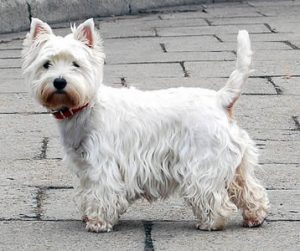
West Highland White Terriers, commonly known as Westies, are a breed of dog known for their distinctive white coat. Originating in Scotland, the breed was used to seek and dig out foxes and badgers. This breed is commonly recognised through its use as a mascot for Black & White (a brand of Scotch whisky), Cesar brand dog food, and various other logos.
Appearance
Commonly, Westies have bright, deep-set eyes that are dark in colour. Their ears are small, pointed, and erect. A male typically weighs between 15 and 20 pounds (6.8 and 9.1 kg) and a female between 13 and 16 pounds (5.9 and 7.3 kg). average height is 9 to 11 inches (23 to 28 cm) at the withers. The Kennel Club has recommended that their tails, typically “carrot-shaped”, should never be docked; hence the tail should be between 5–6 inches (13–15 cm).
They also have deep chests, muscular limbs, a huge skull, a large black nose, a short and a closely fitted jaw with “scissors” bite (lower canines locked in front of upper canines, upper incisors locked over lower incisors). Their teeth generally appear quite large for the size of the dog. Westies have a very strong bone structure for their size.
They have a soft, dense undercoat and a rough outer coat, about 2 inches long, that requires regular grooming. Some Westies have “wheaten tippings” on their backs, though for individuals put forward for conformation showing this can be regarded as undesirable. Also, some Westies do not have a top coarse coat, and just a second silky coat.
This breed is a non-shedding dog. As they develop into adults, their thinner “puppy coat” is normally removed by either ‘hand-stripping’ or otherwise clipping.
Craniomandibular osteopathy
Westie puppies may be affected by craniomandibular osteopathy, a disease also known “lion jaw”. (The disease is an autosomal recessive condition and so a puppy can only be affected by it if both its parents are carriers of the faulty gene.) With this disease, the only current way to identify carrier breeding stock is if an affected puppy is produced. Therefore, breeders may be unaware that breeding stock are carriers until an affected puppy is born. Craniomandibular osteopathy is a non-neoplastic proliferative disease of the ventral mandibular ramus, occipital base of the skull and tympanic bullae, characterised by excessive bone deposition in these areas. In most incidences, the defect is bilateral, although this is not always the case. The disease varies in severity, the region(s) affected and the individual pain threshold of the affected puppy. Definitive diagnosis is achieved by radiographic examination.
Craniomandibular osteopathy is extremely painful to the puppy. Affected puppies will most likely display signs of pain or discomfort, such as yelping, when their head is touched and when chewing or eating. The puppy may be lethargic and be reluctant to eat as a result.
The condition usually manifests when the puppy is around 3–6 months of age, and regresses spontaneously around 12 months of age. Treatment of the disease is concerned with managing the symptoms and providing appropriate analgesia to improve quality of life and enable the puppy to eat until the disease resolves spontaneously. Corticosteroids are the usual therapeutic agents used to manage the disease. The exact treatment protocol depends on the severity, localisation and pain sensitivity of the affected puppy. In extreme cases, euthanasia may be required.
—————————————————————————————————————–
CARING FOR YOUR DOG NEWSLETTER – Delivered Directly To Your Inbox – Starting Immediately – SIGN UP FOR FREE TODAY
—————————————————————————————————————–
